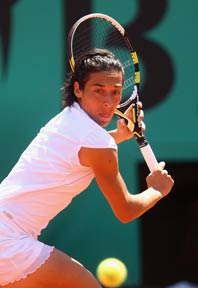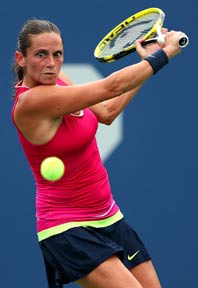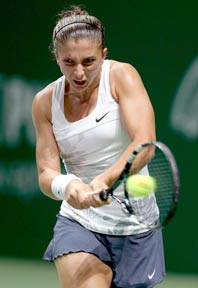|
TennisOne Lessons Proverbial Lessons from Italian Women Doug Eng EdD, PhD In years past, we sounded the alarm that the Russians were coming: Kournikova, Dementieva, Safina, Kuznetsova, Myskina and Sharapova. Then we couldn’t stop talking about the phenomenal Belgians, Clijsters and Henin. A few years ago, we thought the Chinese women would foray into the top echelons of tennis: Zheng Jie, Peng Shuai and Li Na. But in recent years, one of the most successful groups has been the Italian women. Their splash into success was a low-keyed ripple, quite unspectacular compared to the Russians or Belgians. Yet, some of the best lessons can be learned from the Italian women. Francesca Schiavone won Roland Garros three years ago. Sara Errani reached world number six last year. Errani paired up with Roberta Vinci to win three majors in doubles Vinci reached #12 in mid-April. Despite presently injured, Flavia Pennetta, made her way all the way up to #12 and was the first Italian woman to be ranked #1 in doubles. The Italians were Fed Cup Champions in 2006, 2009, 2010 and runner-ups in 2007. Enough said?
They are not your towering Sharapovas, not your powerful Serenas, and not your athletic Stosurs. Rather, none of them have dominating power games since they tend to be among the smaller players on the tour. Schiavone, Errani and Vinci all stand 5’4” or 5’5”. In fact, granted that the average height of a sixteen year old (American) girl is 5’4”, one has to wonder why don't more young players model their games after an Errani or Vinci. Instead the popular models are the less attainable Maria Sharapova or Serena Williams. Far more, however, can be learned from the Italian women.
There are several defining strengths of the Italian women. They are excellent movers, very hard workers and among the fittest players. They are excellent all-court players who are strong at the net and in doubles. And what is unusual is the number of one-handed backhands in a world of two-handed backhands. Here are some lessons — each matched to an Italian proverb — that the ordinary player can learn. Chi la dura la vince (She who lasts, wins) Schiavone, Errani, Vinci and many of the Italian women don’t win with big offensive games. All three are 5’5” or less. Flavia Pennetta towers over them at 5’8”. Therefore they need to find other ways to win. Being Europeans, they tend to excel on clay courts, which developed their shot tolerance and fitness. Shot tolerance is the ability to mentally stay in a rally producing the same consistent shots over and over again. Less patient players will go for winners earlier, making unnecessary errors. The Italians are quite stingy in giving up points. Fitness and shot tolerance go well together since they allow a player to grid out long rallies. There are two things you can do:
Anche la legna storta dà fuoco diritto. (Also the crooked woodsticks make straight fire) One does not need perfect firewood to make a fire. The Italians show that they can win without a conventional or perfect game. Vinci and Errani don’t have the serve of a Serena Williams or the pure pace of Maria Sharapova.
Interestingly, half of the Italian women in the top 100 in the past two years have one-handed backhands: Schiavone, Vinci and Alberta Brianti. That’s also about half of all the women with one-handed backhands in the WTA top 100. And none of these women are big. Conventional thinking suggests that smaller players need two-handed backhands to play well. We think smaller players need power and have trouble getting high balls. Going against the current grain, the Italian women show that it is not true. Even more fascinating is Roberta Vinci’s slice backhand. Like Steffi Graf, she uses it exclusively but she does not have Steffi’s big forehand, serve, or foot speed. Rather Vinci has a strong net game, superb fitness, and a strong mental game. Perhaps she does not win many baseline rallies, but she does not lose them, either. Two years ago, Errani had the slowest serve among the top 100 WTA players. She changed racquets to add a little more power. Errani shows that there are ways of playing without overpowering opponents. Errani also has an unusual two-hander. Her left or top hand does not close around the racquet grip but rather she leaves a gap between fingers with the thumb open and parallel to the racquet. Her power grip style might help her on high backhands. So doing things a bit unusual can work. Here’s some practical advice. Focus on consistency on your weaker side. Look for ways to cover up your weakness. If you play mostly your best shots or if you reduce errors on the weaker side, you have better chances to win. Fare un baffo (make a moustache of it)
This odd saying refers to not giving a care what people think. There are several ways how the Italians score big. For all Schiavone cares, she took charge of the 2010 Roland Garros finals playing to win, not to lose. She volleyed her way fearlessly to win where even John McEnroe had to compliment her. Schiavone played out of pure joy passion not to gain fans or sign autographs. For a player who had been playing professionally for 13 years and never made the semi-finals of majors before she won in Paris, the accomplishment was extraordinary. Sara Errani had the slowest serve among the top 100 women on the tour less than two years ago. So she switched racquets and made a run to the top. Like Steffi Graf, Roberta Vinci has a one-handed backhand that’s all slice and she is highly ranked. To overcome any weaknesses, self-consciousness must be eliminated. Part of playing in the zone of optimal performance (i.e., the perfect mental game), is to free oneself of self-limiting thoughts. Francesca Schiavone was just shy of 30 years old when she stunned the tennis world by winning Roland Garros. She was the first notable player to awaken us to the reality there’s life after 30. For a long time, we think that tennis players are teenage prodigies and peak in their low 20s and are washed up before 30. No longer. Today, players peak later with the demanding physical game and more difficult tour schedules. She was the first to really show that one can play past the so-called prime years. Now we see Ferrer, Haas, Petrova, Li Na, play some of their best tennis. And we can’t forget Kimiko Date-Krumm. Sara Errani is listed as 5’5” and was ranked as high as #6 at the end of October last year. Now 30 years old, Roberta Vinci stands 5’4”. The tallest of the Italians is Flavia Pennetta, she cracked the top 10 in 2009 and won the Australian Open Doubles Championship in 2011 with the now-retired Gisela Dulko. Although presently ranked 103 due to injuries, Flavia was actually ranked #1 in doubles before Errani and Vinci. So here’s your lesson:
Stare alle costole (To dog someone's heels)
Even if you are trailing an opponent, if you keep yourself in the match, you have a chance of winning. The Italians are among the best fighters in close matches. They manage points well and fight for every point. Part of this mentality comes from their fitness and shot tolerance as mentioned earlier. But another part of it is mental. It’s about being tough when down or always striving to break your opponent’s serve. Constant pressure can force your opponent to make mistakes. Here are a couple things you can do to help your game:
Mal comune, mezzo gaudio (Trouble shared is halved) Three of the Italian women — Errani, Vinci, and Pennetta — reached the number one ranking in the doubles. They excel since their games are complete all-court. They do most anything well except overpower their opponents. They also won the Fed Cup in 2006, 2007, and 2010. That’s playing well as a team. Sharing is more fun than going it alone. Playing doubles can improve your all-court skills for singles. Playing doubles forces you to be more precise with serve returns and groundstrokes. Playing doubles forces you to work on the offensive game. Here are some tips:
Prendere la palla al balzo (to take the ball at the bounce) All the Italians can volley well. They don’t have powerful serves or groundstrokes but they know how to set up on short balls, hit the approach or drop shot, and finish the point at the net. They are opportunistic and know when they have their opponent in trouble. Here are a couple things you can do:
Fortuna i forti aiuta, e i timidi rifiuta (Fortune favors the bold) Think about your tennis goals. Are you constantly challenging yourself or are you just playing for fun? Challenging yourself is fun. It becomes a game within a game. Even in losing, if you challenge yourself well, you can come away very satisfied. For example, you might try to play against a tough opponent, you might try to get to the net every other point, or you might try for bigger serves. Each challenge is a worthy task and important in order to improve your game. Also think about one or two years in the future. Your challenge may not be improving from a 3.5 to 4.0 player or the team winning the league. It might also be visiting Wimbledon or joining an intense camp. Often pushing yourself and trying to be one step ahead is a fun process. It’s the journey, not the final destination that counts. Your comments are welcome. Let us know what you think about Doug Eng's article by emailing us here at TennisOne.
Doug Eng
In addition, Doug has written over 70 tennis articles and has been translated into several languages. He consults in mental and physical training and researches in technical and tactical analysis. He has received many awards including most recently the 2012 US Olympic Committee Doc Counsilman Award for his work in tennis. Doug is a member of HEAD/Penn National Speakers Bureau. |




